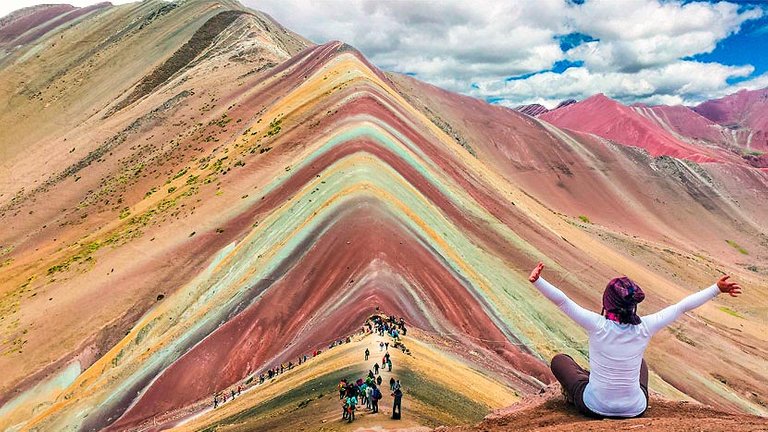About 100 kilometers southeast of Cusco, Peru, there is a mountain rainbow.
It is the mountain of the Seven Colors, also known as Vinicunca or Arcoíris (Rainbow in Spanish)
The mountain is in the Cordillera del Vilcanota at 5,200 meters above sea level, in the district of Pitumarca.
Its slopes and summits are dyed by strips of intense shades of fuchsia, turquoise, lavender and gold.
The visual show that Vinicunca offers attracts visitors since the beginning of 2016, according to Haydee Pacheco, tourism official of the Municipality of Pitumarca.
Thanks to its popularity, also driven by social networks, the hill became a regular destination in the rankings of tourist attractions in the world.
For example, in August 2017, it appeared on the list of 100 places to visit before dying recommended by travel experts on the Business Insider website.
The tourist boom is quite recent, but the history of the mountain and its colors began millions of years ago.
Minerals
The rainbow aspect of Vinicunca is due to "a complex geological history of marine, lake and river sediments," according to a report by the Office of Cultural Landscape of the Decentralized Directorate of Culture of Cusco.
These sediments, transported by the water that once covered the area, date from between the tertiary and quaternary periods, that is, from about 65 to two million years ago.
Over time, the sediments were forming layers (with different sizes of grains) that today are seen as the fringes that attract tourists so much.
The movement of the tectonic plates of the area elevated these sediments until they became mountains.
Then they were acquiring their striking colors because of the oxidation of their minerals, exerted by the humidity of the area, and the erosion of them, explains César Muñoz, member of the Geological Society of Peru (SGP).
Muñoz and the study of the Cultural Landscape Office detail the composition of each strip according to its color.
- Pink or fuchsia: mixture of red clay, fangolitas (mud) and sand.
- White: sandstone (quartz sand) and limestone.
- Purple or lavender: marga (mixture of clay and calcium carbonate) and silicates.
- Red: argillites and clays.
- Green: clays rich in ferro magnesia (mixture of iron and magnesium) and copper oxide.
- Yellowish brown, mustard or golden: limonites, calcareous sandstones rich in sulfur minerals (combined with sulfur).
Fabián Drenkhan, a researcher at the Institute of Nature Sciences of the Pontifical Catholic University of Peru, said that these mixtures also contain iron oxides, which are usually reddish in color.


Oh wow, how cool is that? Nature always finds a way to amaze us! I wish I can visit one day, thanks for sharing
Yeah, nature is something awezome, thanks for the comment <3